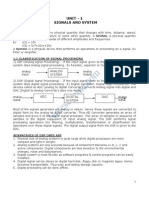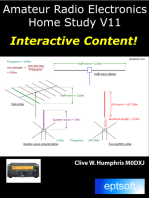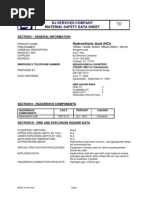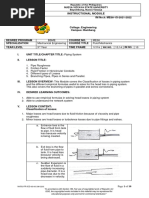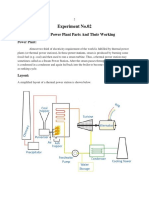..
Uploaded by
Fidel Cabiles..
Uploaded by
Fidel CabilesSignals, Spectra and Signal Processing (EC413L1)
Chapter 1 INTRODUCTION TO DIGITAL SIGNAL PROCESSING
1.0 Introduction Digital signal processing (DSP) is an area of science and engineering that has developed rapidly over the past 30 years. This rapid development is a result of the significant advances in digital computer technology and integrated circuit fabrication. Many of the signal processing tasks that were conventionally performed by analog means are realized today by less expensive and often more reliable digital hardware. When digital circuits are available and have sufficient speed to perform real-time signal processing, digital signal processing solutions provide more elegant and less expensive solutions. Less cost, greater reliability, more flexibility and high accuracy and precision: these are the reasons why there has been an explosive growth in digital signal processing theory and applications over the past three decades.
1.1 Signals, Systems and Signal Processing
A signal is defined as any physical quantity that varies with time, space or any other independent variable or variables. We can also describe a signal as a function of one or more independent variables. The signal
is a signal which varies linearly with t, and the signal
is a signal that varies quadratically with t. As another example, the function
describes a signal of two independent variables x and y.
Chapter 1 Introduction to Signal Processing
Page 1
Signals, Spectra and Signal Processing (EC413L1)
There are cases where a functional relationship between the dependent and independent variables is unknown or too highly complicated to be of any practical use. Example of which are speech signal, electrocardiogram, electroencephalogram, etc. A segment of speech may be represented to a high degree of accuracy as a sum of several sinusoids of different amplitude and frequencies, that is, as
where A i (t ) , Fi (t ) , and i (t ) are sets of possibly time-varying amplitudes, frequencies and phases, respectively
Figure 1.1 Segment of speech
An electrocardiogram (ECG) is a signal generated by a persons heart. An electroencephalogram (EEG) is a signal generated by a persons brain. A system is defined as a physical device (and the software that comes with it) that performs an operation on a signal. For example, a filter used to reduce the noise and interference corrupting a desired information-bearing signal is called a system. Systems are implemented through hardware (physical circuitry) and software (programming).
The operation performed by the system onto the signal is called signal processing. Signal processing is also defined as the extraction of information from the signal to make it desirable.
Chapter 1 Introduction to Signal Processing
Page 2
Signals, Spectra and Signal Processing (EC413L1)
The method or set of rules for implementing the system by a computer program that performs the corresponding mathematical operation is called the algorithm. In DSP, major efforts are done in devising computationally efficient, fast and easily implementable algorithms for performing operations such as filtering, correlation and spectral analysis.
1.1.1 Basic Elements of a Digital Signal Processing System
Figure 1.2. Analog signal processing system
Most of the signals encountered in science and engineering are analog in nature, that is, the signals are functions of continuous variables.
Analog signals can be analyzed and processed through analog means by using analog circuitry or processors.
DSP provides an alternative method for processing the analog signal.
Figure 1.3. Block diagram of a digital signal processing system
To perform the process digitally, there is a need for an interface between the analog signal and the digital processor, called the analog-to-digital converter.
The digital signal processor may be a large programmable digital computer or a small microprocessor programmed to perform the desired operations on the input signal. It may also
Chapter 1 Introduction to Signal Processing
Page 3
Signals, Spectra and Signal Processing (EC413L1)
be a hardwired digital processor configured to perform a specified set of operations on the input signal. In applications where the digital output from the digital signal processor is to be given to the user in analog form, we must provide another interface from the digital domain to the analog domain, called a digital-to-analog converter. In some cases, DAC is not needed, as the information will be given to the user in digital form.
1.1.2 Advantages of Digital over Analog Signal Processing A digital programmable system allows flexibility in reconfiguring DSP operations. Accuracy is much better controlled by digital systems; analog circuit components have tolerable parameters which make it difficult for designers to achieve high accuracy. Digital signals are easily stored on magnetic and solid-state media, making it possible for easier transport and access. DSP allows performance of more sophisticated mathematical operations on signals. In some cases, DSP systems are cheaper than their analog counterparts, mainly because of flexibility or availability of cheaper processors.
1.2 Classification of Signals 1.2.1 Multichannel versus Multidimensional Signals Signals that are generated by multiple sources are called multichannel signals. Example: ECG, EEG, ground acceleration due to an earthquake. Multichannel signals can be expressed as vectors. For instance, the ground acceleration due to an earthquake has three components: primary wave travelling longitudinally, secondary waves travelling transversely, and surface waves travelling near the surface of the ground. Thus, this signal can be expressed as the vector
s t = s t s t
Chapter 1 Introduction to Signal Processing
Page 4
Signals, Spectra and Signal Processing (EC413L1)
Figure1.4. Three components of ground acceleration due to an earthquake nearby
Signals that are dependent on two or more variables are called multidimensional signals. Example: images, video signal.
Image signals are two-dimensional signals; i.e. dependent on two variables. The intensity or brightness of a picture element is a function of its coordinates x and y on a rectangular coordinate scale. Black-and-white television signals, on the other hand, are three-dimensional signals; i.e. dependent on three variables. The intensity of each picture element, aside from its space coordinates, is also dependent on the time (since video are considered moving pictures).
Chapter 1 Introduction to Signal Processing
Page 5
Signals, Spectra and Signal Processing (EC413L1)
A color TV picture may be described by three intensity functions corresponding to the brightness of the three principal colors (red, green, blue) as functions of space-time coordinates. Hence it is a three-channel, three-dimensional signal.
Figure 1.5. Image as a two-dimensional signal
1.2.2 Continuous-Time versus Discrete-Time Signals Continuous-time signals are defined for every value of time (and hence, take on any possible values). These signals can be described by functions of continuous variables. Examples: speech waveform of Figure 1.1, x t = cos t, x t = e for < t < +. Discrete-time signals are defined only at specific values of time. Example: x t = e for n = 0, 1, 2 . If we use the index n of the discrete-time instants as the independent variable, the signal value becomes a function of an integer value, that is, it becomes a sequence of numbers. In this course, we shall denote x(t) as a continuous-time signal and x(n) as discrete-time signal. In later sections, we shall establish important relationships between the continuous-time index t and discrete-time index n.
Chapter 1 Introduction to Signal Processing
Page 6
Signals, Spectra and Signal Processing (EC413L1)
Figure 1.6. (a) Continuous-time signal; (b) Discrete-time signal
In applications, discrete-time signals may arise in two ways: o Through sampling, or selecting values of an analog signal at discrete-time instants. o By accumulating a variable over a period of time. Example: Wolfer sunspot numbers.
Figure 1.7. Occurrence of sunspots is an example of discrete-time data
1.2.3 Continuous-Valued Versus Discrete-Valued Signals If a signal takes on all possible values on a finite or an infinite range, it is said to be continuousvalued signal. If a signal takes on values from a finite set of possible values, it is said to be discrete-valued signal.
Chapter 1 Introduction to Signal Processing
Page 7
Signals, Spectra and Signal Processing (EC413L1)
Note that: o A continuous-time signal is automatically continuous-valued signal. This signal is considered an analog signal. o A discrete-time signal is obtained by the process called sampling the analog signal. Sampling the analog signal, however, does not make the signal discrete-valued. To make a discrete-time signal discrete-valued, an additional process called quantization must be done. o A discrete-time, discrete-valued signal is the one considered a digital signal.
Figure 1.8. Digital signal
1.2.4 Deterministic Versus Random Signals The mathematical analysis and processing of signals requires the availability of a mathematical description, called the signal model, for the signal itself. Thus, we can describe signal the way they are mathematically modeled. Deterministic signals are any signals that can be uniquely described by an explicit mathematical expression, a table of data, or a well-defined rule. This term is used to emphasize the fact that all past, present and future values of the signal are known precisely, without any uncertainty. Random signals are signals that evolve in time in an unpredictable manner. Most of the practical signals fall under this category, as these are cannot be described to any reasonable degree of accuracy by explicit mathematical formulas, or such description is too complicated to be of any practical use.
Chapter 1 Introduction to Signal Processing
Page 8
Signals, Spectra and Signal Processing (EC413L1)
Figure 1.9. Two random signals with almost the same histogram
The analysis and description of random signals are accomplished using statistical techniques instead of explicit formulas. The mathematical framework for the theoretical analysis of random signals is provided by the theory of probability and stochastic processes. Example:Classify the following signals according to whether they are (1) one or multi dimensional; (2) single or multichannel; (3) continuous time or discrete-time and (4) analog or digital. Give a brief explanation. A color movie Weight and height measurements of a child taken every month Speech signal Image on an LCD monitor Stereo sound White Gaussian Noise Gold code
Chapter 1 Introduction to Signal Processing
Page 9
Signals, Spectra and Signal Processing (EC413L1)
1.3 The Concept of Frequency in Continuous-Time and Discrete-Time Signals 1.3.1 Continuous-Time Sinusoidal Signals A simple harmonic oscillation is mathematically described by the following continuous-time sinusoidal x t = A cos t + , < < + 1.3.1
Figure 1.10. Analog sinusoidal signal
This signal is characterized by three parameters: 1. The amplitude A 2. The analog angular frequency in radians per second 3. The phase in radians sinusoid repeats. The angular frequency can be expressed as
F
This signal is periodic with period T = . Tp indicates the length of time the pattern of the = 2F
1.3.2
thus Eq. 1.3.1 can be written as
x t = A cos 2Ft + , < < + with F as the frequency whose dimension is cycles per second or Hertz (Hz). The signals defined by Eqs. 1.3.1 and 1.3.3 has the following properties o For every fixed value of the frequency F, xa(t) is periodic.
1.3.3
Chapter 1 Introduction to Signal Processing
Page 10
Signals, Spectra and Signal Processing (EC413L1)
Continuous-time sinusoidal signals with distinct (different) frequencies are themselves distinct. o Increasing the frequency F results in an increasing rate of oscillation of the signal. These properties are carried over to the class of complex exponential signals o x t = Ae e
1.3.4
This can be easily seen when we express Eq. 1.3.4 in terms of sinusoids using the Eulers identity = cos j sin A e 2
1.3.5 A e 2
Using Eq. 1.3.5, we can express Eq. 1.3.3 into the following form x t = A cos t + = +
1.3.6
Thus, we can say that a sinusoidal signal can be obtained by adding two-equal amplitude complex-conjugate exponential signals, sometimes called phasors.
Figure 1.11. Representation of a cosine function by a pair of complex-conjugate exponentials (phasors)
As time progresses, the phasors rotate in opposite directions (the positive frequency denotes counterclockwise direction; negative frequency denotes clockwise direction). The rate of rotation hence of oscillation is the angular frequency , the instantaneous phase or angle from the reference point is given by t + , and the amplitude of the phasor is denoted by its length A/2.
Chapter 1 Introduction to Signal Processing
Page 11
Signals, Spectra and Signal Processing (EC413L1)
1.3.2 Discrete-time Sinusoidal Signals A discrete-time sinusoid signal may be expressed as x n = A cos n + The signal is characterized by three parameters o A is the amplitude o is the discrete angular frequency o is the phase < < 1.3.7
Figure 1.12. Discrete-time sinusoidal signal with = /6 and = /3
This signal is periodic with period N. It indicates the number of samples before repeating a pattern. The angular frequency can be expressed as = 2f 1.3.8 < n < +
thus Eq. 1.3.7 can be written as
where f has the dimensions cycles per sample
x n = A cos 2fn +
1.3.9
The discrete-time sinusoid has the following properties: o A discrete-time sinusoid is periodic only if its frequency f is a rational number. o Discrete-time sinusoids whose frequencies are separated by an integer multiple of 2 are identical. Identical signals separated by 2 are called aliases.
Chapter 1 Introduction to Signal Processing
Page 12
Signals, Spectra and Signal Processing (EC413L1)
o The highest rate of oscillation in a discrete-time sinusoid is attained when = or equivalently when f = . From = 0 (f = 0) to = (f = ), the rate of oscillation increases. Beyond this, up to = 2 (f = 1) the rate of oscillation decreases.
Figure 1.13. Signal x(n) = cos
n for various values of the frequency
As for the case of continuous-time signals, negative frequencies can be introduced as well for discrete-time signals. For this purpose, we use the identity x n = A cos n + =
A
1.3.15
The fundamental range for the frequency of the discrete-time sinusoid is < < or <f< . Examples: 1. Determine which of the following sinusoids are periodic and compute their fundamental period. cos 0.01n cos sin cos 3n sin 3n
Chapter 1 Introduction to Signal Processing
Page 13
Signals, Spectra and Signal Processing (EC413L1)
2. Determine whether or not each of the following signals is periodic. In case a signal is periodic, specify its fundamental period. x t = 3 cos 5t + 6 x n = 3 cos 5n + 6 x n = 2 exp j n 6 x n = cos n 8 cos n 8 x n = cos n 2 sin n 8 + 3 cos n 4 + 3 1.3.3 Harmonically Related Complex Exponential These are sets of periodic complex exponentials with fundamental frequencies that are multiples of a single positive frequency. Continuous-time exponentials. The basic signals for continuous-time, harmonically related exponentials are s t = e
From these, we can take note that:
= e
k = 0, 1, 2, 3
1.3.16
All of sk(t) are periodic with a common period Tp. F0 is allowed to take any value and all members of the set are distinct, in the sense that if k1 k2 then s1(t) s2(t). From the basic signals of Eq. 1.3.16, we can construct a linear combination of harmonically related complex exponentials of the form x t = c s t = c e
1.3.17
This signal is periodic with fundamental period Tp = 1/F0, and its representation in terms of the above equation is called the continuous-time Fourier series expansion for xa(t). The complex-valued constants ck are the Fourier series coefficients and the signal sk(t) is called the kth harmonic of xa(t). Discrete-time exponentials. Choosing f0 = 1/N to ensure the periodicity of our complex exponential, we define the sets of harmonically related complex exponentials by s n = e From these, we can take note that: There are only N distinct periodic complex exponentials in the set of sk. All members of the set have a common period N. We can choose exactly N members of this set in accordance to the sequence s n = e
/N
, k = 0, 1, 2, 3 . . .
1.3.18
, k = 0, 1, 2, 3 . . . N -1
1.3.19 Page 14
Chapter 1 Introduction to Signal Processing
Signals, Spectra and Signal Processing (EC413L1)
From this, we can form a linear combination of harmonically related complex discrete-time exponentials with fundamental frequency f0 = 1/N. It is of the form x n =
N
c s n =
c e
/N
1.3.20
This signal is periodic with fundamental period N, and its representation in terms of the above equation is called the discrete-time Fourier series expansion for x(n). The complexvalued ck are the Fourier series coefficients and sk(n) is called the kth harmonic of x(n).
Reference: John G. Proakis, Dimitris G. Manolakis. Digital Signal Processing: Principles, Algorithms, and Applications: Third Edition. Prentice Hall, New Jersey. 1996
Chapter 1 Introduction to Signal Processing
Page 15
You might also like
- Key Notes Lecture 1 Introduction To Signal ProcessingNo ratings yetKey Notes Lecture 1 Introduction To Signal Processing3 pages
- Signal Spectra, Signal Processing Lecture Part 2No ratings yetSignal Spectra, Signal Processing Lecture Part 296 pages
- Introduction To Discrete Time Signals & System100% (1)Introduction To Discrete Time Signals & System119 pages
- Digital Signal Processing: Instructor: Munazza SadafNo ratings yetDigital Signal Processing: Instructor: Munazza Sadaf16 pages
- Unit-1: Digital Signal Processor Class NotesNo ratings yetUnit-1: Digital Signal Processor Class Notes31 pages
- Nguyen Thanh Tuan, M.Eng. Department of Telecommunications (113B3) Ho Chi Minh City University of Technology Nguyen Khanh Loi, M.EngNo ratings yetNguyen Thanh Tuan, M.Eng. Department of Telecommunications (113B3) Ho Chi Minh City University of Technology Nguyen Khanh Loi, M.Eng16 pages
- Slide-1 Introduction To Signal ProcessingNo ratings yetSlide-1 Introduction To Signal Processing104 pages
- Digital Signal Processing Module 1 BPUT SyllabusNo ratings yetDigital Signal Processing Module 1 BPUT Syllabus80 pages
- 6th Sem - ETC - Digital Signal Processing - STUDY MATERIALNo ratings yet6th Sem - ETC - Digital Signal Processing - STUDY MATERIAL58 pages
- BEC505 - Digital Signal Processing - NOTESNo ratings yetBEC505 - Digital Signal Processing - NOTES102 pages
- SM 6th SEM Etc Digital Signal ProcessingNo ratings yetSM 6th SEM Etc Digital Signal Processing37 pages
- Some Case Studies on Signal, Audio and Image Processing Using MatlabFrom EverandSome Case Studies on Signal, Audio and Image Processing Using MatlabNo ratings yet
- Technical Specification of 1 X 630 RM 2XY: Technical Particulars Unit Offered DataNo ratings yetTechnical Specification of 1 X 630 RM 2XY: Technical Particulars Unit Offered Data1 page
- Unit Operations Lab, CHE 322 Spring 2021No ratings yetUnit Operations Lab, CHE 322 Spring 20215 pages
- Cubic Foot Weight of Crushed Bituminous Coal: Standard Test Method ForNo ratings yetCubic Foot Weight of Crushed Bituminous Coal: Standard Test Method For4 pages
- Differential Pressure Level Solutions BU01C25A04-01EN-Y - 002No ratings yetDifferential Pressure Level Solutions BU01C25A04-01EN-Y - 0027 pages
- Wellbore Stability - Principles and Analysis in Geothermal Well DrillingNo ratings yetWellbore Stability - Principles and Analysis in Geothermal Well Drilling84 pages
- Tanquillas Plasticas Gas y Agua CiudadesNo ratings yetTanquillas Plasticas Gas y Agua Ciudades17 pages
- Modified Atmosphere Packaging: Nazir Mir and Randolph M. Beaudry Michigan State University East Lansing, MichiganNo ratings yetModified Atmosphere Packaging: Nazir Mir and Randolph M. Beaudry Michigan State University East Lansing, Michigan10 pages
- ICT Project Management Status Checklist.No ratings yetICT Project Management Status Checklist.3 pages
- Machining and Machine Tool Operation PI GATE 2020 Previous Year With Ans KeyNo ratings yetMachining and Machine Tool Operation PI GATE 2020 Previous Year With Ans Key21 pages
- Control Your Motors With L293D and Arduino PDFNo ratings yetControl Your Motors With L293D and Arduino PDF11 pages
- SDS1022 / SDS1102 Digital Storage Oscilloscope User ManualNo ratings yetSDS1022 / SDS1102 Digital Storage Oscilloscope User Manual66 pages
- Schematic EMC WIRING 2020-05-23 22-49-18No ratings yetSchematic EMC WIRING 2020-05-23 22-49-181 page
- Key Notes Lecture 1 Introduction To Signal ProcessingKey Notes Lecture 1 Introduction To Signal Processing
- Digital Signal Processing: Instructor: Munazza SadafDigital Signal Processing: Instructor: Munazza Sadaf
- Nguyen Thanh Tuan, M.Eng. Department of Telecommunications (113B3) Ho Chi Minh City University of Technology Nguyen Khanh Loi, M.EngNguyen Thanh Tuan, M.Eng. Department of Telecommunications (113B3) Ho Chi Minh City University of Technology Nguyen Khanh Loi, M.Eng
- 6th Sem - ETC - Digital Signal Processing - STUDY MATERIAL6th Sem - ETC - Digital Signal Processing - STUDY MATERIAL
- Some Case Studies on Signal, Audio and Image Processing Using MatlabFrom EverandSome Case Studies on Signal, Audio and Image Processing Using Matlab
- Learn Amateur Radio Electronics on Your SmartphoneFrom EverandLearn Amateur Radio Electronics on Your Smartphone
- Analog Dialogue, Volume 47, Number 1: Analog Dialogue, #9From EverandAnalog Dialogue, Volume 47, Number 1: Analog Dialogue, #9
- Analog Dialogue, Volume 48, Number 1: Analog Dialogue, #13From EverandAnalog Dialogue, Volume 48, Number 1: Analog Dialogue, #13
- Analog Dialogue, Volume 45, Number 4: Analog Dialogue, #4From EverandAnalog Dialogue, Volume 45, Number 4: Analog Dialogue, #4
- Technical Specification of 1 X 630 RM 2XY: Technical Particulars Unit Offered DataTechnical Specification of 1 X 630 RM 2XY: Technical Particulars Unit Offered Data
- Cubic Foot Weight of Crushed Bituminous Coal: Standard Test Method ForCubic Foot Weight of Crushed Bituminous Coal: Standard Test Method For
- Differential Pressure Level Solutions BU01C25A04-01EN-Y - 002Differential Pressure Level Solutions BU01C25A04-01EN-Y - 002
- Wellbore Stability - Principles and Analysis in Geothermal Well DrillingWellbore Stability - Principles and Analysis in Geothermal Well Drilling
- Modified Atmosphere Packaging: Nazir Mir and Randolph M. Beaudry Michigan State University East Lansing, MichiganModified Atmosphere Packaging: Nazir Mir and Randolph M. Beaudry Michigan State University East Lansing, Michigan
- Machining and Machine Tool Operation PI GATE 2020 Previous Year With Ans KeyMachining and Machine Tool Operation PI GATE 2020 Previous Year With Ans Key
- SDS1022 / SDS1102 Digital Storage Oscilloscope User ManualSDS1022 / SDS1102 Digital Storage Oscilloscope User Manual




























